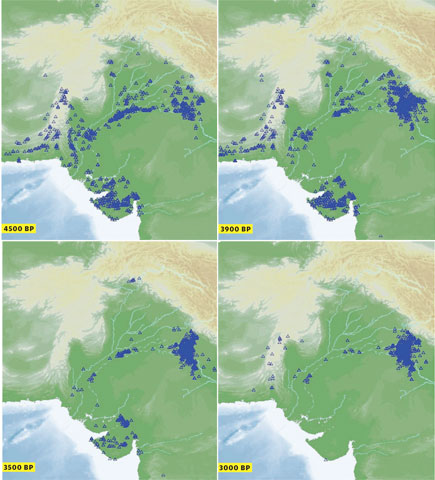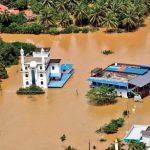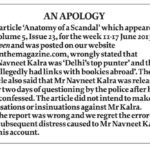The Truth about the Saraswati
Could the river system that sustained the Harappans be the same as this most sacred Rg Vedic river? Some new geological findings
 Hartosh Singh Bal
Hartosh Singh Bal
 Hartosh Singh Bal
|
23 Aug, 2012
Hartosh Singh Bal
|
23 Aug, 2012
/wp-content/uploads/2015/11/the-saraswati.jpg)
Could the river system that sustained the Harappans be the same as this most sacred Rg Vedic river? Some new geological findings
The identity of the Saraswati, and its fate, has been one of the most enduring enigmas of ancient Indian history. It is a period of our history that in any case is not short of unanswered questions, ranging from the fate of the Harappans to the identity of the Rg Vedic people. For most Indians, these questions connect with the very nature of Indian society. From the origins of the caste system to the possible migration of Indo-Europeans into the subcontinent, the story of our past is deeply tied to our present.
A recent paper published in the prestigious Proceedings of the National Academy of Sciences (PNAS) of the USA, compiled from data collected by an international team of geologists, archaeologists and botanists, sheds much needed light on many of these questions. Given the extent of what is at stake, not all the claims in the paper, nor all its findings, are likely to be accepted without arguments. But even so, its conclusions are of immense value in providing details of a past we are just beginning to understand.
The paper titled ‘Fluvial landscapes of the Harappan civilization’ clears up the geological history of both the Indus and Ghaggar-Hakra river systems and provides a compelling story of how changes in the monsoon led to the growth and decline of the Harappan civilisation.
This much is not in question. More controversially, while the paper is cautious about the identification of the mythic Saraswati with the Ghaggar, the press release from the prestigious Woods Hole Oceanographic Institution announcing the research makes the categorical claim that ‘The study also resolves a long-standing debate over the source and fate of the Sarasvati, the sacred river of Hindu mythology’.
Both aspects of the paper are fascinating, but they are best separated because arguments over the latter claim should not take away from the importance of what is revealed about the first.

The maps, adapted from the original published in the Proceedings of the National Academy of Sciences (PNAS), show the distribution of archaeological sites in the Indus domain. Some 3,900 years ago, the movement upwards along the course of the Ghaggar-Hakra was already visible, and 3,500 years ago the entire middle course of the Ghaggar-Hakra had been abandoned, with only a few settlements surviving near the Indus; BP=Before Present
THE RISE AND FALL OF HARAPPA
The paper provides a description of the major rivers of the Harappan civilisation, of their change and evolution, and how this impacted the civilisation. Liviu Giosan, geologist with the Woods Hole Oceanographic Institution and lead author of the study, says, ‘We reconstructed the dynamic landscape of the plain where the Indus Civilization developed 5,200 years ago, built its cities, and slowly disintegrated between 3,900 and 3,000 years ago.’
Their conclusion gives the clearest picture yet of the fate of the Harappans. According to Giosan, ‘The Harappans were an enterprising people taking advantage of a window of opportunity—a kind of “Goldilocks civilization”. As monsoon drying subdued devastating floods, the land nearby the rivers—still fed with water and rich silt—was just right for agriculture. This lasted for almost 2,000 years, but continued aridification closed this favorable window in the end.’
The story that the paper puts together is compelling. It is tied to the weakening of the monsoon over the subcontinent, a fact that has now been attested to by a number of independent studies. Some 5,000 years ago, as the monsoon started to weaken, the flooding of the rivers became less intense and regular across Punjab.
The rivers of the Indus system, fed by snow-melt from the Himalayas, underwent a change. As the silt from the monsoon declined, they started incising river valleys. According to Giosan, ‘There is a fine balance between deposition and erosion along rivers. If you decrease the sediment relative to the water in a river you favor erosion. In the case of Indus Himalayan tributaries water is perennial and provided by melting. All these rivers incised and their incised valleys are wide (km to tens of km).’
It is within these flood valleys along the Indus and its tributaries that most of the Harappan settlements on this river system have been found. The incised valley acted as a flood plain and agriculture depended on the regular and periodic flooding within the valley.
The story was different on the other major river system of the Harappan civilisation—the Ghaggar-Hakra. Often identified with the mythic Saraswati of Rg Vedic and Puranic literature, Giosan and his team determined that this river system has had no connection with either the Yamuna or the Sutlej in the past 10,000 years.
Giosan offers a straightforward explanation: ‘No incised connection from either Yamuna or Sutlej exists to the Ghaggar-Hakra system.’ This needs to be decoded. Since both the Yamuna and the Sutlej are Himalayan rivers, like the Indus rivers, they would have been incising their course within the past 10,000 years. The absence of any incised connection from the two rivers to the Ghaggar indicates that these connections did not exist during the past 10,000 years.
The team also noted a lack of incision along the course of the Ghaggar-Hakra. According to Giosan, ‘Lack of a wide incised valley tells us that rivers of the Ghaggar-Hakra did not behave like all other Himalayan rivers. Flow in these monsoonal rivers can be perennial or seasonal. For a perennial flow you need enough monsoon rain to recharge groundwater to insure a baseflow during the dry season. For a seasonal flow the groundwater is not recharged enough to insure baseflow.’
Giosan’s team has correlated the geological date with the pattern of settlement of the Harappan towns along the two river systems. This indicates that the Ghaggar-Hakra was perennial for much of the Harappan period, and till as late as 2,900 years ago, water, whether seasonally or perennially, may have flowed all the way to the Nara valley in Sindh.
As the accompanying maps (see facing page) of Harappan settlements and their dating shows, some 3,900 years ago, the movement upwards along the course of the Ghaggar-Hakra was already visible, and some 3,500 years ago, the entire middle course of the Ghaggar-Hakra had been abandoned, with only a few settlements surviving near the Indus.
Just focusing on the Ghaggar-Hakra during the period of Harappa’s decline tells an interesting story. The western part of the river system sees a decrease from 174 sites to 41 and the settled area decreases from 974 to 209 hectares. In the upper or eastern course, the site number actually increases from 218 to 853, but the settled area only rises from 2,943 hectares to 2,985 hectares. It seems the larger urban sites along the entire course were giving way to numerous smaller sites on the upper course, indicating an urban collapse. This is reflected in the Indus settlements as well with the total settled area declining while the number of sites rises. According to co-author Dorian Fuller, an archaeologist at University College London, ‘We can envision that this eastern shift involved a change to more localized forms of economy: smaller communities supported by local rain-fed farming and dwindling streams. This may have produced smaller surpluses, and would not have supported large cities, but would have been reliable.’
According to Giosan, this collapse is not simply a matter of the drying up of the Ghaggar-Hakra:
‘I cannot favor this explanation because the Indus domain was vast—decadence in one region could have been compensated by the other regions. And why would folks from the Indus system leave their houses if the GH would dry but their rivers would still flood reliably? The floods on the Indus system also probably started to be irregular and/or [were] not large enough to insure the previous way of life—this coupled with drastic reduction of flow on Ghaggar-Hakra led to a crisis across the whole Harappan domain—this is what we favor now as an explanation.’
This explanation is also supported by the agricultural record of the Harappan settlements, which shows a significant shift in the later phase from winter crops, which depend on the flooding of the rivers, to summer crops directly dependent on rain rather than the river.
THE GHAGGAR-HAKRA AND THE SARASWATI
The press release on the paper goes on to make a stronger claim: ‘In another major finding, the researchers believe they have settled a long controversy about the fate of the mythical river, the Sarasvati. The Vedas, ancient Indian scriptures composed in Sanskrit over 3,000 years ago, describe the region west of the Ganges as “the land of seven rivers. ’’ Easily recognizable are the Indus and its current tributaries, but the Sarasvati, portrayed as “surpassing in majesty and might all other water’’ and “pure in her course from mountains to the ocean,’’ was lost. Based in scriptural descriptions, it was believed that the Sarasvati was fed by perennial glaciers in the Himalayas. Today, the Ghaggar, an intermittent river that flows only during strong monsoons and dissipates into the desert along the dried course of Hakra valley, is thought to best approximate the location of the mythic Sarasvati, but its Himalayan origin and whether it was active during the Vedic times remains controversial.’
To reiterate, the paper states that for the past 10,000 years, the Ghaggar-Hakra was a monsoon-fed river system and had no connection with any river originating in the Himalayas, including the Yamuna and the Sutlej. Moreover, it was a perennial river probably flowing to the sea, but its course started drying more than 3,900 years ago and it was in likelihood a seasonal river a few centuries later.
On the face of it, this identification of the Saraswati with the Ghaggar is logical. Rg Vedic descriptions of the river place it between the Sutlej and the Yamuna, and talk of its course extending from the hills to the sea. In later Puranic literature, the river is often described as vanishing. This provides a surprisingly good match with the Ghaggar-Hakra as described by the geological evidence.
Ashok Akjulkar, professor emeritus in the department of Asian Studies at University of British Columbia, has compiled all the references to the Saraswati in the Rg Veda and analysed them textually without ‘pre-conceptions’ in a forthcoming paper that he made available to Open.
Akjulkar’s conclusions, which were in place before Giosan’s paper was published, seem to resonate strongly with the research: ‘Our study has revealed that there indeed was a river S, although even in its first appearance it comes with a cloak of deification and mythology. We will not be justified in thinking of it only as a metaphor for the nighttime sky or as a deity. Nor do we need to think of the Rg Vedic S as an entity with a nostalgia-born or imported name. Further, we will be justified in setting aside two assumptions of the past—that the S had a wide or impressively broad bed and that it was glacier-fed. As a consequence, we do not any longer need to appeal to shifts in the courses of the Sutlej and Yamuna, to assuming which some scientists… seem to have rightly objected. Nor do we need to face objections based on the assumption of a single stream…’
He has shared his yet to be published paper with Giosan, who told Open, “I have seen a new and exciting interpretation of the Vedic writings on the subject… it is amazing how accurate those descriptions were and how perceptive if the scholar who interprets them does not put his own preconceptions into the interpretation.’’
In light of the paper authored by Giosan et al, the identification of the Ghaggar with the Saraswati has another implication. Since the Ghaggar seems to have begun drying up some 3,900 years ago, the Vedic people who describe the river as flowing from the hills to the sea must have been on its banks well more than 3,900 years ago. This implies some contact between the Harappans and the Vedic people, and in the extreme case, it can be used to suggest that they were one and the same.
Steve Farmer, a comparative historian who along with the well-known Rg Vedic scholar Michael Witzel has been a combative opponent of those he feels use history for political ends, says, ‘I find ALL attempts to identify the Sarasvati with a single historical river quite off base. The Rg Veda is a heavily stratified document, as we’ve known since the 19th century, meaning it is a compilation from different times and to some extent different geographical regions as well.
To speak of “the” Sarasvati to me seems quite naive philologically, since there are many different *kinds* of references to the river in different layers of the text. Some may be based on one historical river or other. Others are clearly mythological references.
Writers who try to identify “the” Sarasvati to my mind demonstrate above all that they are at best amateur philologists and don’t know much about how ancient texts were put together.
Again, of course, this is the opinion of a comparative historian and not a world expert on the RV…. But for me the answer is clear, and the question itself is a non-starter.’
Rajesh Kochhar, astrophysicist and author of The Vedic People, Their History and Geography, much before Giosan et al’s recent paper, had already made a case against identifying the Ghaggar with the Saraswati: ‘The Rg Veda describes the Saraswati as a mighty river cutting its banks as it emerges from the hills. Irrespective of whether the Yamuna or Sutlej joined it further along the course, this description cannot apply to the upper course of the Ghaggar.’
In keeping with the spirit of Farmer’s critique, Kochhar has proposed a different scenario altogether. For him, the description of the Rg Vedic Saraswati better fits river systems in Afghanistan, and he suggests that the Vedic people migrated down to the Punjab roughly 3,700 years ago, after the proposed urban collapse of the Harappans. It is at this point they applied the name Saraswati to a weakened Ghaggar, hence the description of its disappearance in later Puranic literature. Thus the Rg Vedic and the Puranic descriptions of the Saraswati actually refer to different rivers.
Kochhar also adds that the argument for the migration of the Rg Vedic people is based on evidence other than the Saraswati: ‘None of these matters can be considered in isolation. There is the linguistic evidence associating the language of the Rg Veda with the Avestan of the Iranians.’
The body of linguistic evidence suggests that Sanskrit is not the original Indo-European language but is rather a sister language to other Indo-European languages such as Greek. Moreover, the close affiliation of the Rg Vedic language with the Avestan of Iran and the presence of non-Indo European sounds in the language has been used to argue for an initial Indo-European homeland outside India, a separation of the Indo-Iranian stock from this homeland and then a migration of the Rg Vedic people into India where contact with other language families introduced non Indo-European elements present even in the earliest hymns of the Rg Veda.
Compelling as this case is, purely on theoretical grounds, a scenario that suggests an Indian homeland for Indo-Europeans, a migration of Indo-Europeans out of the subcontinent some 6,000 years ago, followed by a later migration of the Indo-Iranians and then the spread of the Vedic people east and southwards in the subcontinent where they encountered other language groups, also meets the evidence.
But beyond the linguistic evidence, there is other evidence from the Rg Veda itself that argues against an Indian homeland. Kochhar points out that ‘Soma occupies as central a place in the Rg Veda as Saraswati.The best possible match for the mythic Soma that has been invoked so often in the Rg Veda is the stimulant Ephedra, which does not grow in the Punjab plains. The Rg Vedic people must have dwelt at higher altitudes at some point of time.’
Clearly then the debate is anything but settled, but Kochhar, like Akjulkar, agrees that more scientific work on the Ghaggar is needed, and stresses the need to move away from political use of the evidence. The work of Giosan et al, he feels, needs to be supplemented by the ‘geological study of the upper course of the Ghaggar. And we must be ready to change our conclusions depending on the evidence, even if we happen to find the conclusions unpalatable.’
Ashok Akjulkar was spelled incorrectly as Ajulkar when the article was published. The error is regretted
About The Author
CURRENT ISSUE
The Unbearable Lightness of Being Rahul Gandhi
MOst Popular
3

/wp-content/uploads/2025/04/Cover-Congress.jpg)











More Columns
Ukraine silently encroaches on ‘friendly’ Moldova Ullekh NP
NFRA chief Ajay Pandey joins AIIB Rajeev Deshpande
The Revenge of Roughage V Shoba